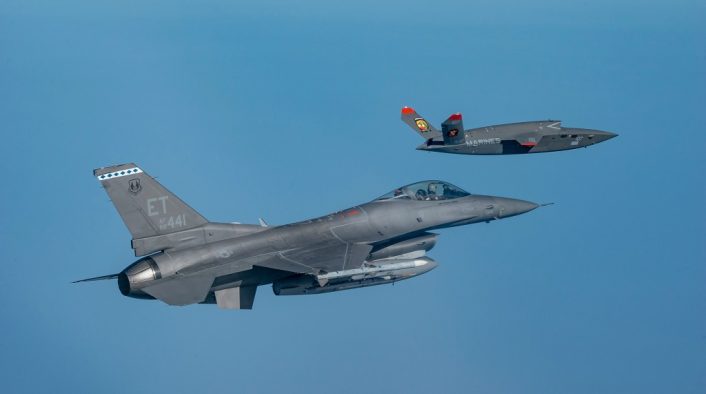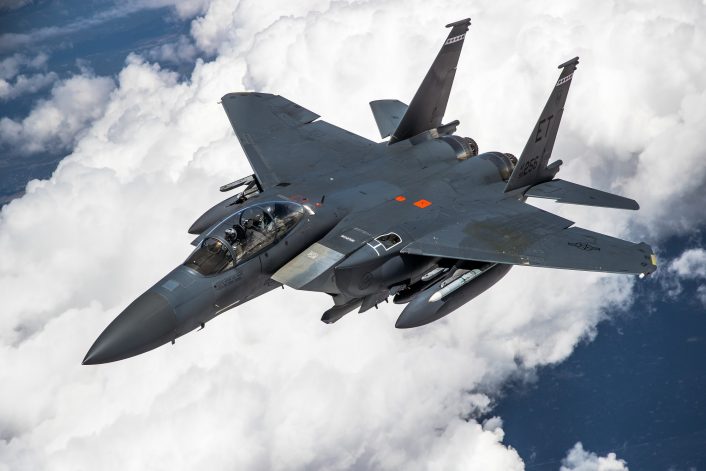Pilots aboard an F-16C Fighting Falcon and an F-15E Strike Eagle each controlled two XQ-58A Valkyrie unmanned aircraft in an air combat training scenario.
In a groundbreaking test which has been defined as “a major leap in human-machine teaming,” the U.S. Air Force recently demonstrated the ability to have multiple autonomous collaborative platforms (ACPs) flying alongside crewed fighter aircraft. The test saw the pilots of an F-16C Fighting Falcon and an F-15E Strike Eagle each controlling two XQ-58A Valkyrie unmanned aircraft in an air combat training scenario at Eglin Air Force Base, Florida.
The test
The press release from the Air Force Research Laboratory (AFRL) says the goal of the XQ-58’s integration into air combat scenarios is to reduce pilot workload while enhancing situational awareness and mission effectiveness. The test appears to be the result of a joint effort, as the press release mentions it was supported by the Department of Defense’s Rapid Defense Experimentation Reserve program under the Office of the Undersecretary of Defense for Research and Engineering and executed by Air Force Materiel Command’s Air Force Research Laboratory and Air Force Test Center, Air Combat Command, and U.S. Navy.
“With this flight, we mark a crucial step in developing capabilities that harness human-machine teaming to overcome complex threats and expand our advantages,” said Brig Gen. Jason E. Bartolomei, commander of Air Force Research Laboratory. “By developing and integrating autonomous platforms with manned systems, we can quickly adapt, increase combat effectiveness, and reduce risk to our aircrews in contested environments.”

The role of the broader ACP category is seemingly similar to the one of the more specific Collaborative Combat Aircraft (CCA) program and the lessons learned with the former will surely help in the introduction of the latter. This is also mentioned by AFRL, saying that “data from the recent flight demonstration will inform future development and deployment of semi-autonomous capabilities across the Department of Defense.”
The work on human-machine teaming is at the forefront of the innovations being introduced by the U.S. Air Force, which is modernizing to meet the demands of a more contested and complex operating environment. The unmanned platforms are considered “a key enabler of future airpower,” supporting manned assets with “credible mass” and allowing higher operational flexibility.
“This test with ACPs directly addresses the evolving requirements of modern warfare and the needs articulated by our warfighters,” said Gen. Ken Wilsbach, commander of Air Combat Command. “We are committed to innovation and integrating ACPs through these kinds of demanding, operator-driven evaluations that allow us to learn rapidly and enhance our human-machine teams. This approach is fundamental to sharpening our combat capabilities, maintaining air superiority and ensuring we can effectively support the joint force in complex future environments.”
The press release further added that “ACPs provide affordable, runway-flexible capabilities that can operate semi-autonomously in high-risk environments, […] while enabling operators to retain strategic and ethical oversight.” The ethics of having these unmanned force multipliers flying around autonomously in contested environments has been in the spotlight since the beginning of these tests, with the Air Force and industry “committed to building AI technologies that are responsible, equitable, traceable, reliable, and governable.”

The XQ-58A Valkyrie
The XQ-58A Valkyrie is a runway-independent, high-speed, long-range unmanned combat aerial vehicle (UCAV) developed by Kratos Defense & Security Solutions in partnership with the Air Force Research Laboratory (AFRL). Part of AFRL’s Low Cost Attritable Aircraft Technology (LCAAT) effort, the Valkyrie is designed to deliver high utility at a fraction of the cost of traditional platforms.
Engineered as an attritable aircraft, the XQ-58A is low-maintenance and reusable, yet affordable enough to be considered expendable in high-threat environments. From contract award to first flight in 2019, the aircraft was developed in just two and a half years, demonstrating the benefits of accelerated acquisition and commercial manufacturing methods.
The Valkyrie’s design incorporates a stealth-optimized fuselage, V-tail, and internal payload bay. It is launched from a ground-based rail and recovers via parachute, making it runway-independent and highly flexible in deployed operations.
The XQ-58A can support a variety of missions, including strike, ISR, electronic warfare, decoy, and comms relay. It has also successfully demonstrated manned-unmanned teaming with fifth-gen aircraft. In a notable 2021 test, an XQ-58A released an ALTIUS-600 Small Unmanned Aerial System (SUAS) from its internal bay, showcasing its capability as an airborne launch platform for loitering munitions or other UAS.

A Block 2 variant with improved structure, payload, and operational capability first flew in 2022. The updated version is part of ongoing integration and testing at Eglin AFB, Florida, where multiple Valkyries have been delivered for evaluation under Skyborg and Autonomous Attritable Aircraft Experimentation programs.
In 2023, the Valkyrie flew a three-hour mission with AFRL-developed AI flight software, marking a major milestone in autonomous air combat. As testing continues under ABMS and CCA, the Valkyrie will help inform future development and deployment of semi-autonomous unmanned capabilities.









